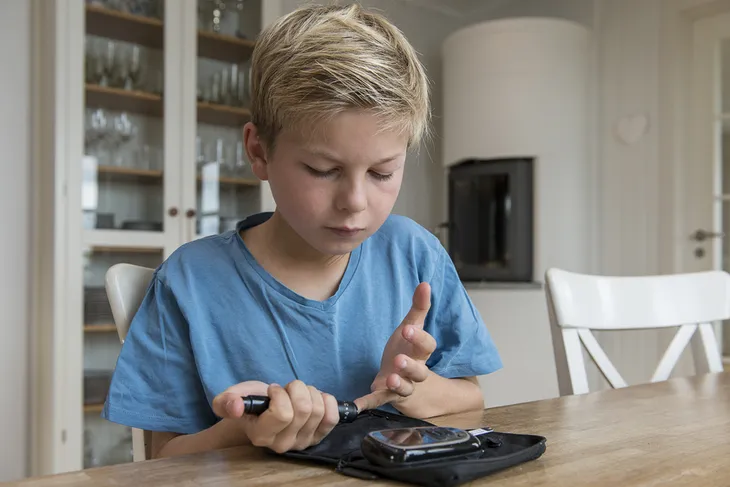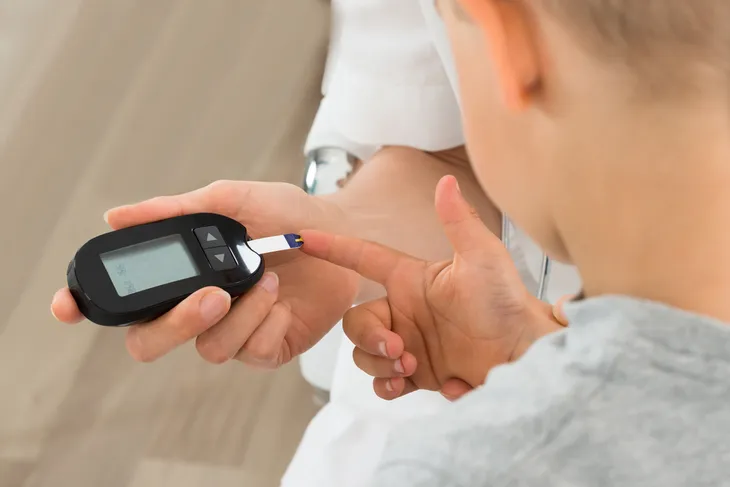Diabetes is often thought of a disease related to adults, mainly those who are obese. But that’s not accurate – statistics show around 18,000 people under the age of 20 are diagnosed with type 1 diabetes each year in the U.S., and that number was on an upward trend in the first decade of the millennium.
Type 1 differs from type 2, in that type 1 is an autoimmune disease that attacks your pancreas and halts it from producing the hormone that regulates blood sugar. In contrast, type 2 can develop later in life from a set of risk factors, with obesity being one of them. If your child has type 1 diabetes (once referred to as juvenile diabetes), there are some things you should know to help them manage the disease and improve their quality of life. Here are 12 of them…
Want diabetes content delivered straight to your inbox? Sign up for our Diabetes newsletter and receive exclusive news and articles written from our team of diabetes experts.
1. Monitor Blood Sugar Often
One of the biggest adjustments as a caregiver to a child with type 1 diabetes is ensuring their blood sugar is within a normal range (especially when they can’t do it themselves). But it’s not just a daily check – WebMD notes that this might entail checking your child’s blood glucose (sugar) as many as 12-times per day.
The source also notes that you can get better at keeping levels within a healthy range through practice, and you’ll begin to recognize behaviors when blood sugar is too high or too low. For example, low blood sugar (hypoglycemia) is common for those with type 1 diabetes, and carries signs such as shakiness, sweating, pale skin, and clumsiness.
2. Help Measure and Administer
Getting doses of the hormone that regulates blood sugar is part of life for those with type 1 diabetes. But as a parent and caregiver, it might take some guesswork at first to determine how much of the medication your child needs, whether it’s by syringe or a pump, notes WebMD.
The site notes that keeping a log of when and how much you administer, as well as taking the timing of meals and activity into consideration, can help you arrive at the right formula. But it also notes that if you give too much or too little, don’t be too hard on yourself. Remember that the results of checking blood sugar is a gauge, not a report card. You’ll learn the reactions and be able to make adjustments for the future.
3. Recognize Symptoms of High/Low Blood Sugar
As mentioned, you’ll likely get the hang of what to look for when it comes to determining doses for your child. But you can educate yourself ahead of time if your child has just been diagnosed with type 1 diabetes.
Diabetes.co.uk explains that high blood sugar (hyperglycemia) can present itself as frequent need to urinate, nausea, “extreme” thirst, blurred vision, and drowsiness. Meanwhile, low blood sugar (hypoglycemia) can carry symptoms such as shaking, dizziness, extreme hunger, and irritability, adds the source.
4. Encourage Healthy Eating
As KidsHealth.org explains, the diet for those with type 1 diabetes is really no different than a healthy diet for those without the disease. The site notes that eating a balanced diet is important, and developing a meal plan (including three meals and snacks) is also a key to helping your child stay within manageable levels of blood sugar.
The source explains that different types of foods will have different impacts on blood sugar. For example, foods that are heavy in carbohydrates (such as bread, cereal, pasta and others that are considered relatively healthy) will cause the biggest spikes in blood sugar, whereas foods that are heavy in proteins and fats don’t have the same dramatic effect. And yes, they can have sweets, as long as they’re tracked.
5. Involve Your Child In Diabetes Management
While you can ensure your child is eating right and getting the right amount of the hormone that regulates glucose in the blood, involving them early in the process is beneficial, notes Diabetes.ca. That might mean teaching them how to read a glucose meter, or choosing a finger that will be used for testing, explains the source.
The child will be able to recognize their own symptoms and regulate their intake of medication, which will become more important as they become more independent, adds the source, which points out that there could be programs and resources in your area (such as diabetes camps) that help engage your child about their condition in a safe environment.
6. Create a Diabetes Management Plan For School
You can’t always be there to check on your child – especially when they’re school-aged. That’s why the Centers for Disease Control and Prevention (CDC) recommends developing a Diabetes Management Plan (DMP) that school staff can refer to, ensuring the well-being of your diabetic child.
The DMP is not only to cover the obvious, but also the unexpected. What occurs when there is a substitute teacher? What steps need to be taken for a class trip? What occurs with your child if they have low blood sugar right before a test? What are the steps to make sure the student has a fair shot as if he or she didn’t have to deal with diabetes? These are some things to consider.
The source notes you should meet with your child’s healthcare team prior to the start of the school year to develop the plan, also known as a Diabetes Medical Management Plan (DMMP). You should then meet with key staff at your child’s school (such as the principal or school nurse) to review the plan, which can include information about ideal blood sugar range, medication requirements, a meal plan, and how to factor in special events and activities, it notes.
7. Encourage Physical Activities
All children need to be active, whether they are diabetic or not, as regular activity is important for both physical and mental well-being. However, if your child has type 1, then you should be encouraging them to exercise (choose something they actually enjoy, whether it’s simply running outside or joining a sports team), and also educating yourself about the impact of exercise on their blood sugar.
More specifically, exercise will cause your child’s glucose levels to drop. With that in mind, you could give them some carb-rich foods prior to being active (check their levels first) to prevent hypoglycemia, explains EndocrineWeb.com. You may also have to adjust medication levels when your child engages in activity. While the exercise doesn’t have to be strenuous, try to aim for 1-hour of physical activity per day, it adds.
8. Take Special Precautions When They’re Sick
Your child is likely going to get ill at some point, whether it’s a mild cold or a flu. And while that can be a challenge for any child and parent, there’s more to it when your child has type 1 diabetes. EndocrineWeb.com explains that illnesses, even mild ones, can raise your child’s blood glucose levels – and the over-the-counter remedies you turn to could raise it even more.
On the other hand, if you child is vomiting, then their levels will go down. The site notes this might mean more frequent monitoring of glucose levels (also depending on the advice of a doctor). Then there are ketones to consider – which are released by the body when the hormone that regulates glucose in the blood is insufficient, notes the source. If your child is sick, you should measure ketones every 4-hours or so (using urine strips or a meter with a special test strip). Too many ketones in the blood can lead to diabetic ketoacidosis (acidic blood), warns the source.
9. Develop an Away-From-Home Plan
You may already have a diabetes management plan to cover off the school day. However, what if your child is going to camp for a couple of weeks or staying with a relative in another town? Having a child with type 1 diabetes definitely doesn’t mean they can’t have adventures away from home, but you should take some precautions.
WebMD suggests that your child should be wearing a medical alert bracelet/necklace at all times to inform others about their condition. This is non-negotiable. You should also inform any adults that will be supervising your son or daughter that aren’t already familiar with your child’s health condition about symptoms they should be watching out for, and how to deal with them.
10. Schedule Regular Check-Ups
Even when you’re doing everything right to help manage your child’s type 1 diabetes, you should still check in with a doctor every 3 to 6-months, according to HealthLinkBC.ca, and a pediatric endocrinologist every 3 months. Both doctors are part of the team for your child. Call and ask if you can have any tests needed scheduled prior to your appointment so that you can discuss the results at the appointment. This can give you a clearer picture of how the treatment is working for them, notes the source.
The source notes the doctor may do their own glucose testing during the visit, and adjust the treatment if necessary. The amount of the hormone that regulates glucose in the blood and even the type can change as your child develops. Around age 12, a doctor may start to check for complications from diabetes, it adds.
11. Manage Their Diabetes Around Their Life
Remember that kids with diabetes, are still kids. WebMD notes that you should be aiming to manage diabetes around your child’s life, and not vice versa. That means you can let your child eat some sweets now and then (as long as you keep track), and your child can engage in all kinds of physical activity as long as the previously mentioned guidelines are followed.
You don’t have to keep your child home more often than others, with the exception of doctor check-ups, notes the source. The bottom line is that type 1 diabetes shouldn’t limit your child – they should be able to enjoy a normal childhood as long as you have precautions in mind (like when they’re sick), it adds.
12. Help Your Child Transition
WebMD says the right time for a child to transition to diabetes self-care might depend on when they were diagnosed. For example, if your child was diagnosed at a very young age and they are aware of the procedures, they might be ready to monitor their own blood sugar by the time they enter grade school.
However, even then, you as a parent or caregiver should still be prepared to lend a hand, as “there’s no fixed age to manage diabetes without help,” notes the source. You can gradually help them transition by involving them more often with food choices, and help them understand their symptoms and what they mean, it adds. Teens facing adolescence may put up more of a fuss about self-management of their condition, so you might have to be more observant, it notes.















